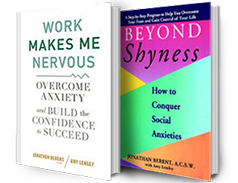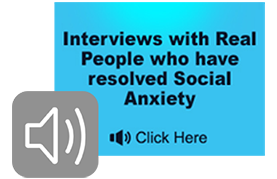If you were walking down the street and you encountered a saber tooth tiger your fight or flight response would be activated. Every human being experiences the phenomenon of fight or flight. Fight or flight is driven by adrenaline. The social anxiety sufferer of any age experiences fight or flight upon interactive or social challenges. Fight or flight, when not controlled, creates panic. Fear of experiencing the adrenaline of flight or fight can create avoidance. Interactive avoidance caused by anxiety is a social phobia.
Common social anxiety scenarios that activate fight or flight include public speaking in formal situations, speaking in public in informal scenarios, fear of being noticeably nervous as in blushing, sweating, or voice stammering, interacting with an authority figure, socializing in general and so on. The common denominator is the fear of being judged.
The adrenaline control technique will help you control the fight or fight response and panic attacks.
Let’s go through the steps.
Step # 1. Have realistic expectations.
This means that your adrenaline will be present when experiencing the challenging situation. Let go of any hope or wish that the adrenaline will not be present. This reality is a crucial component of the physiology of performance. Here’s an example. I’ve done well over a thousand television and radio shows during my career; every kind of show possible; from “Opra” to “Opie and Anthony”. Now I like doing them for many reasons, but an interesting phenomenon always occurs. Approximate 30 or so minutes before a performance my hands get cold. This is vaso-constriction. It’s a build- up of anticipatory energy. I am not nervous. I’m anticipating. It’s adrenaline-driven energy waiting to be released. To me it means “ready set go” as I accept its presence with the interpretation that the adrenaline is my friend and source of energy. “Ready set go” is the opposite, or paradox, of the negative thinking that creates panic. Your adrenaline is going to be there. It’s a fact! It’s an integral force of the flight or fight response which every human being experiences. The paradox of embracing the adrenaline will create power instead of panic!
Step # 2. Accept the adrenaline.
This is the hardest. As I just said, it’s a paradoxical concept. Paradoxical means opposite. It’s a good bet that this is a totally different mind-set for you. Accept the adrenaline with the interpretation that it is your friend and source of power. Identify the very first sensation that you experience when you know that a adrenaline will occur–the very first physical or mental sensation that you experience. Please answer the question now. It’s at this point that your internal critical script usually kicks in with thoughts to yourself like “oh no”,” this is bad”, “I’ve got to get out of here”, and so on. It is at this point that you need to replace the critical thinking with acceptance. In order to make a change you need to be clear on the first sensation or symptom of distress. I’m certainly not saying this change is easy. You’ve probably been conditioned for the negative script for a long time. What I am saying is that replacing the negative with acceptance can be profoundly powerful. Learning his skill takes practice!
Step #3. Surf the wave.
In your mind’s eye create the image of a surfer surfing a wave. Your adrenaline is the wave. In order to achieve a successful ride the surfer goes with the wave. The wave is power. The wave is analogous to the adrenaline. Go with it and you will harness its energy and power. Going with it requires embracing the reality that it will be there. You have a choice. Acceptance it’s power by going with the wave and surfing it or.. Don’t go with it. Don’t accept it and the wave will smash you around; you will fall of the surfboard. Falling off the board is the equivalent of uncontrolled panic.
Step #4. 1 or 2 diaphragmatic breaths.
It’s one thing to know the steps conceptually. It’s another to implement them. This is where skills acquisition and you’re learning curve come into play. The productivity of your skills development will directly be related to proactive thinking and behavior. This is quarterbacking or piloting. In other words; the more you seek out adrenaline opportunities the more you will have the chance for to learn the skill. Passive thinking and defensive behavior will inhibit the learning process and basically get you nowhere. You are going to need to experiment in order to learn a new skill!




